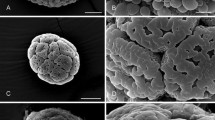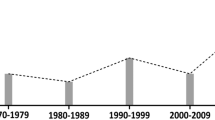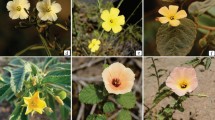Summary
Patterns of arrangement of epicuticular wax platelets are shown in a number of species ofEucalytpus. In some, wax platelets are oriented across the long axes of epidermal cells overlying veins and, in some species, over cells of adjacent stomatal complexes. Among other patterns, radial arrangements around stomata, arrangements in lines at right angles to underlying cell walls and concentric arrays are described. The possibility of the involvement of ectodesmata (ectocythodes) in the location of wax platelets is raised. The pattern of orientation of the platelets is ascribed to a “prepattern”, as yet unobserved, of anisotropic domains in the outer cuticle. It is suggested that this prepattern may consist of regions of molecular anisotropy possibly produced in response to stretching of the cuticle during expansion growth. Wax platelet patterns appear to be restricted to certain taxonomic entities; thus, genetical determinants are also involved in their formation.
Similar content being viewed by others
References
Baker, E. A., 1982: Chemistry and morphology of plant epicuticular waxes. In: The plant cuticle. (Linn. Soc. Symp.10) (Cutler, D. F., Alvin, K. L., Price, C. E., eds.). London: Academic Press.
Barthlott, W., Fröhlich, D., 1983: Micromorphologie und Orientierungsmuster epicuticularer Wachs-Kristalloide: Ein neues systematisches Merkmal bei Monokotylen. Pl. Syst. Evol.142, 171–185.
—,Wollenweber, E., 1981: Zur Feinstruktur, Chemie und taxonomischen Signifikanz epicuticularer Wachse und ähnlicher Sekrete. Tropische und subtropische Pflanzenwelt32 (Akad. Wiss. Lit. Mainz). Wiesbaden: F. Steiner.
Blake, S. T., 1953:. Botanical contributions of the Northern Australian regional survey. 1. Studies on Northern Australian species ofEucalyptus. Aust. J. Bot.1, 185–352.
Blakely, W. F., 1934: A key to the eucalypts. 1st Ed. Sydney: The Worker Trustees.
Franke, W., 1961: Ectodesmata and foliar absorption. Amer. J. Bot.48, 683–691.
—, 1967: Ektodesmen und die peristomäre Transpiration. Planta73, 138–154.
—, 1971: The entry of residues into plants via ectodesmata (ectocythodes). Residue Reviews38, 81–115.
Hallam, N. D., 1970: Growth and regeneration of waxes on the leaves ofEucalyptus. Planta93, 257–268.
—, 1982: Fine structure of the cuticle and the origin of leaf waxes. In: The plant cuticle. (Linnean Soc. Symp.10) (Cutler, D. F., Alvin, K. L., Price, C. E., eds.). London: Academic Press.
—,Chambers, T. C., 1970: The leaf waxes of the genusEucalyptus L'Héritier. Aust. J. Bot.18, 335–386.
Author information
Authors and Affiliations
Rights and permissions
About this article
Cite this article
Carr, D.J., Carr, S.G.M. & Lenz, J.R. Oriented arrays of epicuticular wax plates inEucalyptus species. Protoplasma 124, 205–212 (1985). https://doi.org/10.1007/BF01290771
Received:
Accepted:
Issue Date:
DOI: https://doi.org/10.1007/BF01290771




